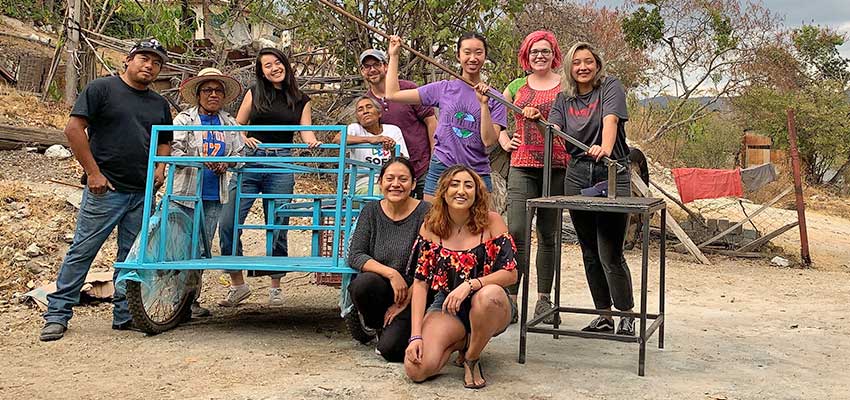
Mountains basking in sunset met us as we stepped off the plane that very first day we landed in Oaxaca de Juárez, Mexico in January. Coming from chilly Boston winter, the Oaxacan warmth was very much appreciated. We, a team of five from MIT, were about to spend the next three weeks in the state of Oaxaca, collaborating on projects with communities in San Pablo Huixtepec, to San Mateo del Mar in the isthmus, to Santiago Suchilquitongo, each very different communities throughout the mountainous region.
Meet the Team
Our team consisted of four students of D-Lab: Development from MIT and our incredible trip leader, Libby Hsu, who is Lecturer and Academic Program Manager at MIT D-Lab! She is from Oregon and fun fact: she’s been to 23 different countries! Students included me, Yu Jing Chen (MIT ‘22), a sophomore in Course 11-6 (Urban Studies and Planning with Computer Science)! I’m from Chicago and fun fact, I’ve learned that I really love tasajo, tasajo, tasajo! Next, we had Chiaki Kirby (MIT ‘20), a senior in Course 2 (Mechanical Engineering)! She’s from Cambridge and fun fact: she hates cilantro. It proved to be very entertaining to watch her pick off the cilantro as she navigated Mexican food, which we quickly learned to be very cilantro heavy, haha! Next up: Julianna Rodriguez (MIT ‘21), a junior in Course 2 (Mechanical Engineering)! She’s from San Diego and fun fact: she backpacked throughout Mexico for three weeks right before our trip. Her ukelele followed us around the whole trip! And last but not least, we had with us Mulan Jiang (MIT ‘23), a first-year thinking of declaring Course 2 (Mechanical Engineering)! She’s from Kansas and fun fact: she’s honestly probably reading Game of Thrones on her phone right now.
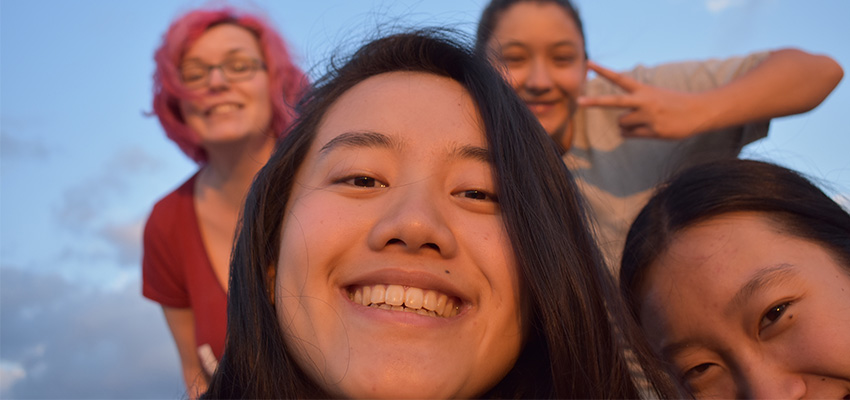
First destination: San Pablo Huixtepec and UTVCO
We spent our first week in San Pablo Huixtepec, a town an hour out from the city of Oaxaca. Oaxin, the nonprofit that helped organize our whole trip here in Oaxaca, has been working with the Universidad Tecnológica de los Valles Centrales de Oaxaca (UTVCO), and this first week, we were to help out in laying down the foundations for organizing bigger projects and CCBs in San Pablo Huixtepec with UTVCO and Oaxin. Built about a decade ago, UTVCO is a premiere public technical institution in San Pablo Huixtepec and is actually the only university in the region. It has currently been working to better integrate the real world and the outside community of San Pablo Huixtepec with the students and their studies in order to help uplift the region, and this goal is what brought upon Oaxin’s collaboration with the university.

Throughout the week, we got the opportunity to do field visits around the community to better understand the local economy and industry that we were working with, in order to identify where the opportunities for future projects and work in the community for Oaxin and UTVCO could be. From honey production to a tomato farm that was dubbed “the king of tomatoes,” we learned a lot about what the economic landscape in the town looked like, as well as the daily lives and operations of locals here.
From bigger operations like a few of the mezcal production operations in town where products were also exported, to small quesillo production where the cheese was primarily sold to neighbors, we were able to gather a lot about the range of issues local community members faced and got a glimpse at the primary actors and stakeholders for potential projects. That first day we were in San Pablo Huixtepec, my head spun with the amount of Spanish I had just been thrown into. My high school junior year AP Spanish wasn’t cutting it. It honestly surprised me how many professors and directors had taken time out of their busy days to do this kind of community engagement. On the day we had a design challenge with a few of the UTVCO students, I quickly realized that they had been excused from all of their classes that morning in order to join our activity. UTVCO had invested a lot into this and into this collaboration.
Being at a public university in Mexico was an experience within itself. This design challenge that the students were tasked with, in which they designed solutions for issues they identified on their campus, was an activity we had already done ourselves in our own class this past semester, designing for problems at MIT. Not only were the differences in the issues we were tackling exacerbated by the fact that we went to school in as privileged of a country as America, but also by the fact that we went to MIT, a private institution with such boundless resources. While we were in class at MIT listing privileged problems like the lack of outdoor outlets, UTVCO students were concerned with how they were unable to use their lab spaces as labs, since classes were being held there for the lack of classroom space. The freedom in major, abundance of resources, and range of classes I had to choose from were all foreign to the students here. The more time I spent here, the more of an anomaly I realized my experience was. I always knew the MIT experience was atypical but it’s very different to see the on-the-ground nuances that define the college experience. Never would it have ever occurred to me that not having to traverse hills for a working bathroom was a privilege to be had without being here.

Even UTVCO was an anomaly in itself; it’s a rather new university with students coming from all over Oaxaca. Being a technical university, there were many resources that not many institutions around the world were able to enjoy. From a soundproof recording studio to an on-campus incubation center for innovation, this school was premier for its time and place. Privilege has many layers, and that’s a lesson I had reinforced here time and time again.
While we were there, we also had a lot of fun, having a little Taki taste test party with the 5 flavors of Takis we were able to find. Exciting times. I know. We even got to learn how to cook tasajo😍 tlayudas from two students of gastronomy from UTVCO and jammed to Julianna’s ukelele and speaker. But like all things, the week crept up on us way quicker than expected, and soon enough, it was time for our next journey.
Five hours of windy mountain roads later…we made it to our next destination: San Mateo del Mar (shoutout to Carlos Morales from Suchilquitongo for making the whole crazy drive).
San Mateo del Mar
The next week, we were to stay for a week in the community of Colonia Juárez in San Mateo del Mar, a small fishing community in the isthmus of Mexico. Through the week, we had amazing food (I didn’t know there were so many ways to cook fish!) and enjoyed sunsets over el Mar Vivo (the Live Sea) and el Mar Muerto (the Dead Sea). I also got to sleep in a Mexican hammock for the week! We also were able to learn a lot about Colonia Juárez. The main source of income in this community is fish, which in the past few years has become a problem of sorts, as the surrounding oceans face the effects of overfishing. With the communities’ main source of livelihood being fishing, it’s been particularly difficult and now, the main source of income has become money from family that had moved and found jobs up north. There was no other way to get money circulating within the community since there was no other way of getting money from outside the community.
Within the past year, the community of Colonia Juárez has been working with Oaxin to create technologies that they could replicate with local materials and potentially sell to external markets. Through Creative Capacity Building workshops, Oaxin helped unlock the potential and empower the women of Colonia Juárez to believe in themselves to build and create. From using tools to cut the defined teeth of fish descaling knives to learning how to solder waterproof fishing lanterns, Oaxin had opened doors for the technologies and creations that the community could make. For many of these women, it was their first time seeing tools like a soldering iron, much less using one.
What was incredibly empowering about this experience, however, was being given the opportunity to be able to work with these women that defined this community. A lot of the working-age men had to move North for work out of necessity to make enough money for the family. The women of the community, though, are the backbones of keeping the community going. From cooking to making clothing to taking care of the house and raising the children, their days are always full. For them to give up so much of their time to join us this week was extremely special.
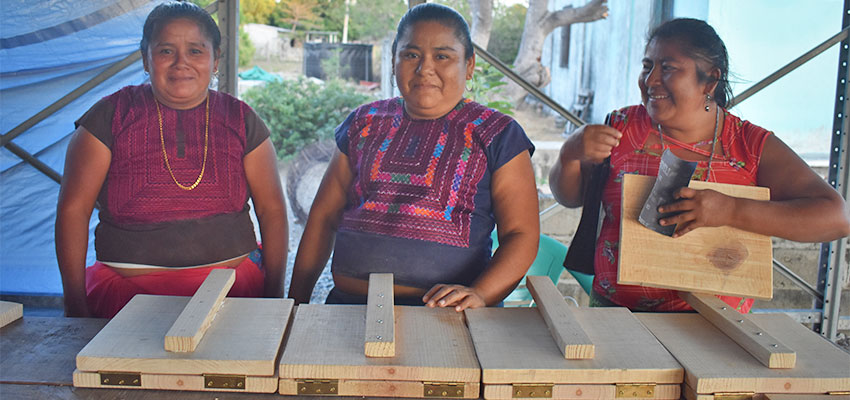
One woman didn’t even let the fact that she just gave birth to a 3-month old baby stop her, but instead, brought beautiful baby Caleb to join us, entertaining us with his puffy little cheeks and the cutest little bucket hats, just so that she could participate and take care of him at the same time. Similarly, our days were instantly brightened by the crowds of children that would come and join us, even trying their hand at seeing who could sand our contraptions the fastest.
This week was a frenzied work week, with a team of the women from Colonia Juárez and a couple of people that Oaxin brought in working to construct a standing yarn spooling machine, another team using angle grinders to build their fish descalers, another team working to brand the textiles they create in order to commercialize outside of San Mateo del Mar, another team assembling and soldering their waterproof fishing lanterns together, and finally, the team that we worked with, the totopo maker team!
During our time in Colonia Juárez, we worked on refining a totopo flattening technology that the women had started building at a CCB a couple of months ago. For those that don’t know, totopos are big cracker-like tortillas with holes in them. Originally imitating the mechanism of a complex machine from China for flattening dough, the original prototype from the earlier CCB had a rolling mechanism with PVC pipes, but without the sophisticated materials and precise machinery that the Chinese machine was made with, it was difficult to implement, especially with the limitations for thickness and size that the totopos presented. We quickly realized together that for the week that we and Oaxin were here, we would not be able to have a functioning product if we stuck with the same design, largely due to the limited resources and tools we had to work with.
With the input and constant feedback from the women working with us, we were finally able to design a new way to flatten totopos, emulating a tortilla press. On the last day, we were able to create a flattening machine that only required a fraction of the time one person took to flatten totopos themselves. While we prototyped one, the women built three more of their own. One woman even had her purse on her shoulder the entire time she was drilling or sawing, which I have to admit is quite the feat.

What I took away, however, is that what I learned throughout this trip was that we weren’t here this month to transform the world, we weren’t here “helping” as if we could solve anything in a week, but that was okay. We were there to learn more about and to actually engage in this kind of community work, contributing whatever we could with our limited outsider perspective to add to these projects. Of course, Oaxin and the women of the community could have done all of this without us. We may have designed a totopo flattener, but what it was at the end of the day was simply two slabs of wood with some screws through it. Enoc, one of the incredible welders that came with us, could have designed this, if not something even more efficient, himself. Of course, our work was beneficial and we were able to leave a positive effect, but it’s not like our totopo maker was going to economically change the game. However, that’s okay, because creating the single best totopo flattener in history was not the goal here. We were here to contribute and apply our learnings in D-Lab to create simple technologies to help make the lives of these women even the least bit easier, but it wasn’t just about the technology. By coming into Colonia Juárez and helping contribute to building their capacity to create, we were building our own capacities and knowledge base to make even bigger and more tangible change and impact in the future. We all have to start somewhere. I found that incredibly powerful.
Final Destination: Suchilquitongo
With the blink of an eye, we were already in our final full week. This week, we were in Santiago Suchilquitongo, a community about an hour out of Oaxaca City. We were joining Tejiendo Alianzas, a nonprofit organization that seeks to make social and economic impact by supporting and accelerating local businesses through programming for sustainable success in local contexts. This week was the first week the nonprofit was working with Lidia, a self-made entrepreneur who with just her donkey and cart, works hard to collect her community’s recycling and sells it to be processed elsewhere. Her community never had a means of recycling before her and now, they count on her coming by every day.
Meet Lidia Castellanos Cruz. Lidia is incredibly hardworking, working from 10 every morning until 8 every evening. During our time with Lidia, she was always putting her heart into everything she did. She was always trying her hand at the tools and trying new skills, unafraid of the unknown. We would be taking breaks and we would see Lidia still hard at work, painting finishing touches on the cart or drilling holes into the wood. Her home sits atop a hill, with her recycling collection lining the path up there, collections of bottles stacked taller than I was. It was quite the operation.
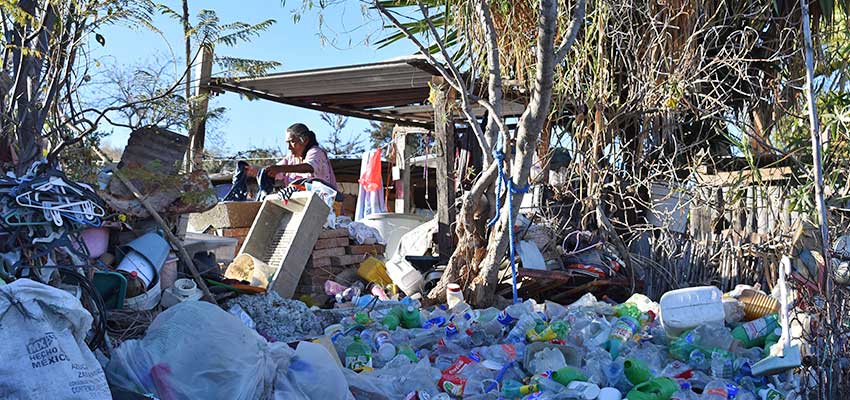
Our task this week was to help her improve her process, in any capacity that we could. We really had free range. The first two days, we spent understanding her process, getting into the nitty-gritty of every step so as to identify where we could feasibly have the most impact with a low-cost technology. Together with Lidia and Sarahi and Richard from Tejiendo Alianzas, we ideated for hours. By the end of it, my head swirled with Spanish and pulsed with the amount of thinking we just did. In the end, we all identified a bottle flattening mechanism and structural changes to one of the carts Lidia uses as the areas that we could most effectively help Lidia with her recycling collection process.
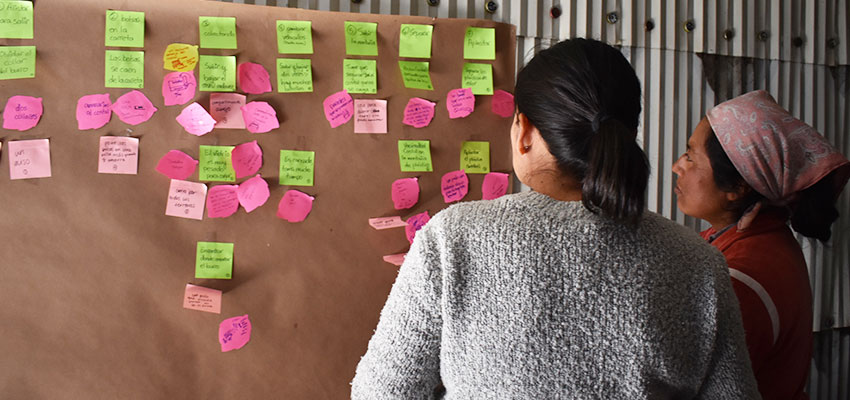
Along with the help of our welder friend, Enoc, we got right to work. Many hours of design and construction later, we were left with two machines that I’m extremely proud of. The most fun part, actually, was the prototype testing, where we just crushed bottle after bottle with our bottle flattening device, the Hulkateca - our machine’s combination name of the Hulk and Zapoteca, an indigenous group in the region. The Hulkateca truly lives up to its name, with a full 25 kilograms just smashing atop the bottles. The other project we worked on was amending Lidia’s recycling collection cart so as to make it easier for her to load and unload her cart. Together, we even spray-painted the whole cart blue!
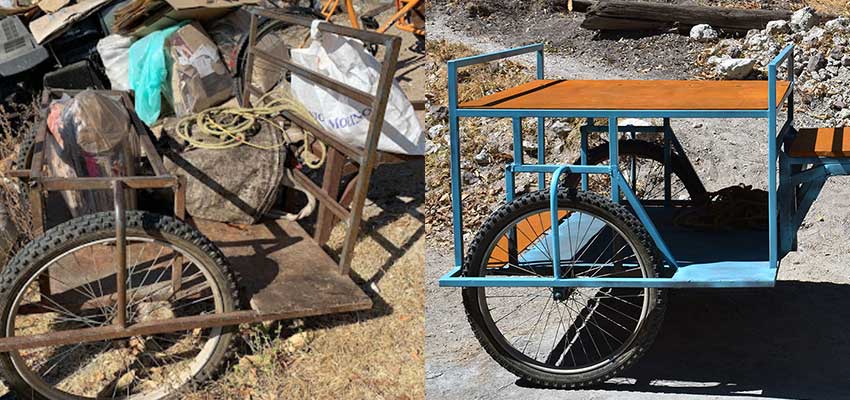
This project was the most hands-on project that we did this month, and Lidia quickly became one of our favorite people. As we were leaving, we thanked her for the commitment and drive she brought to these projects, but in response, she thanked us. She told us that yes, she may be driven and determined, but that it couldn’t get her anywhere if she didn’t have the knowledge or education to build upon, something she never had the opportunity to pursue. During our visit, she was able to have that opportunity, to learn how to use tools and to design. She then stressed the importance of education to us, urging us to stay in school and to study hard, to not worry about working yet because we were young and that this opportunity of education was not something to let go of. I teared up listening to her speak so passionately about education. To be given this privilege of higher education is a powerful thing; don’t give it up.
See you soon, Oaxaca
In no time at all, our time in Oaxaca had come to an end. There really are no words to capture my experience here. I’ve rambled these past few paragraphs trying my best to capture everything - the emotions and beauties and frustrations, all of the above - and ultimately what this trip meant to me but there’s no way I could do it justice. From the bachata and salsa dancing to the karaoke to the kindness of the people we met, Oaxaca is a beautiful place. Thank you, Oaxaca. See you soon. :)
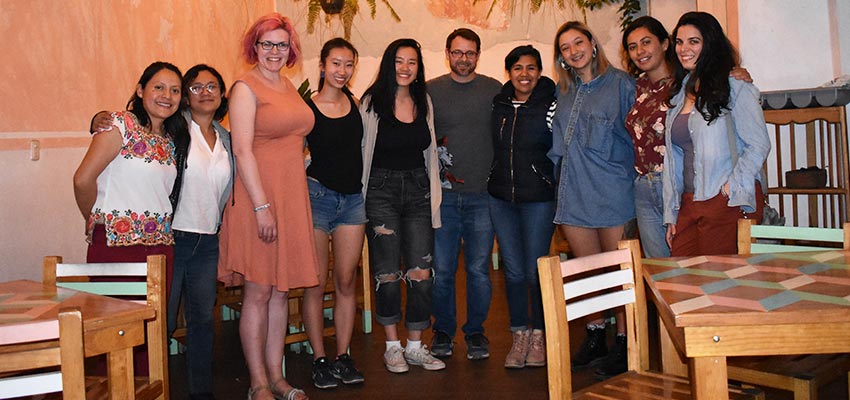
And of course, I cannot just leave you without making you drool over the amazing food I had this January. You’re welcome.

More information
MIT D-Lab class: D-Lab: Development
Contact
Libby Hsu, MIT D-Lab Lecturer and Academic Program Manager

